Role of Teachers in Multicultural Education
VerifiedAdded on 2023/04/20
|18
|6334
|366
AI Summary
This study examines the role of teachers in promoting effective multicultural education. It explores the impact of experienced teachers and multicultural competencies on multicultural education, as well as the ways in which teachers prepare themselves for such programs.
Contribute Materials
Your contribution can guide someone’s learning journey. Share your
documents today.
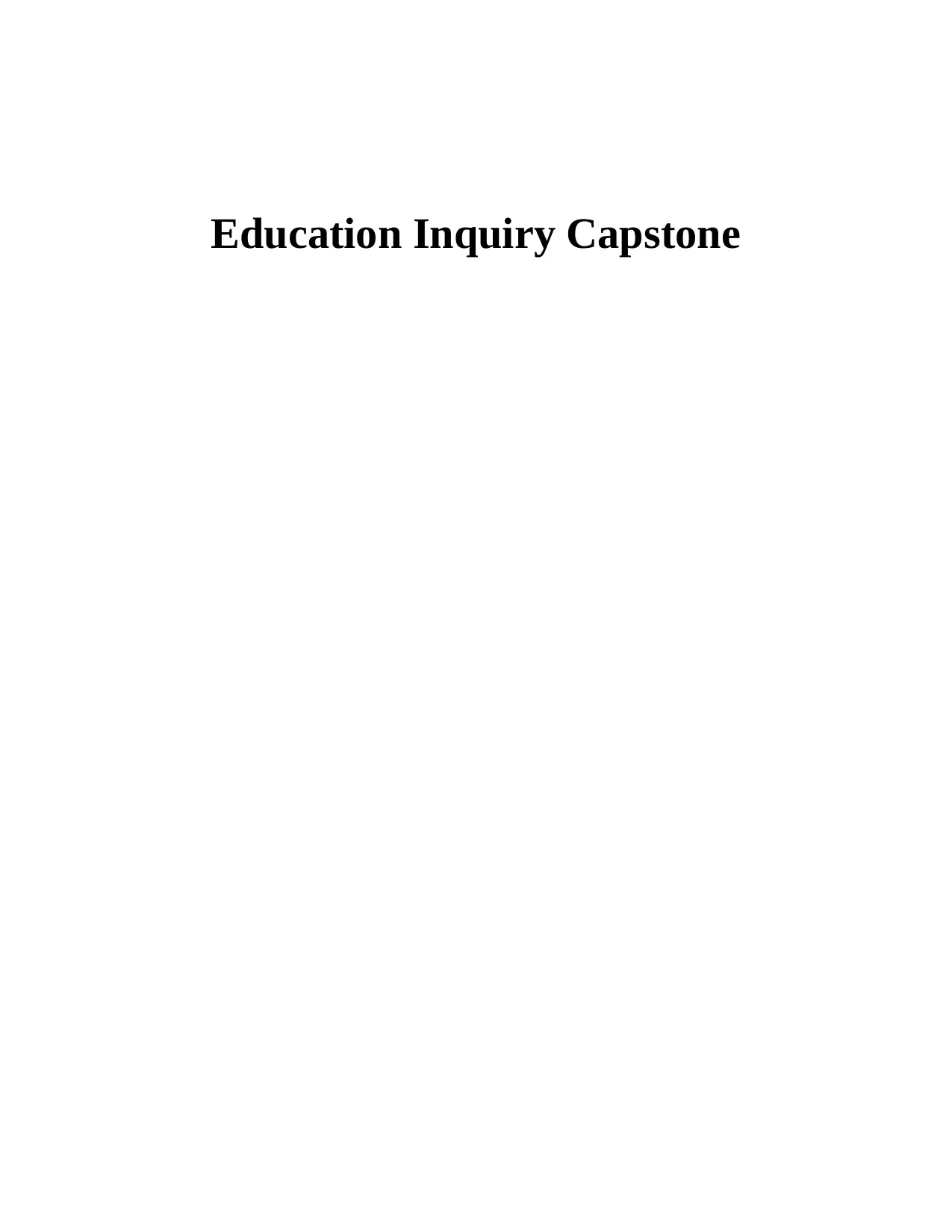
Education Inquiry Capstone
Secure Best Marks with AI Grader
Need help grading? Try our AI Grader for instant feedback on your assignments.
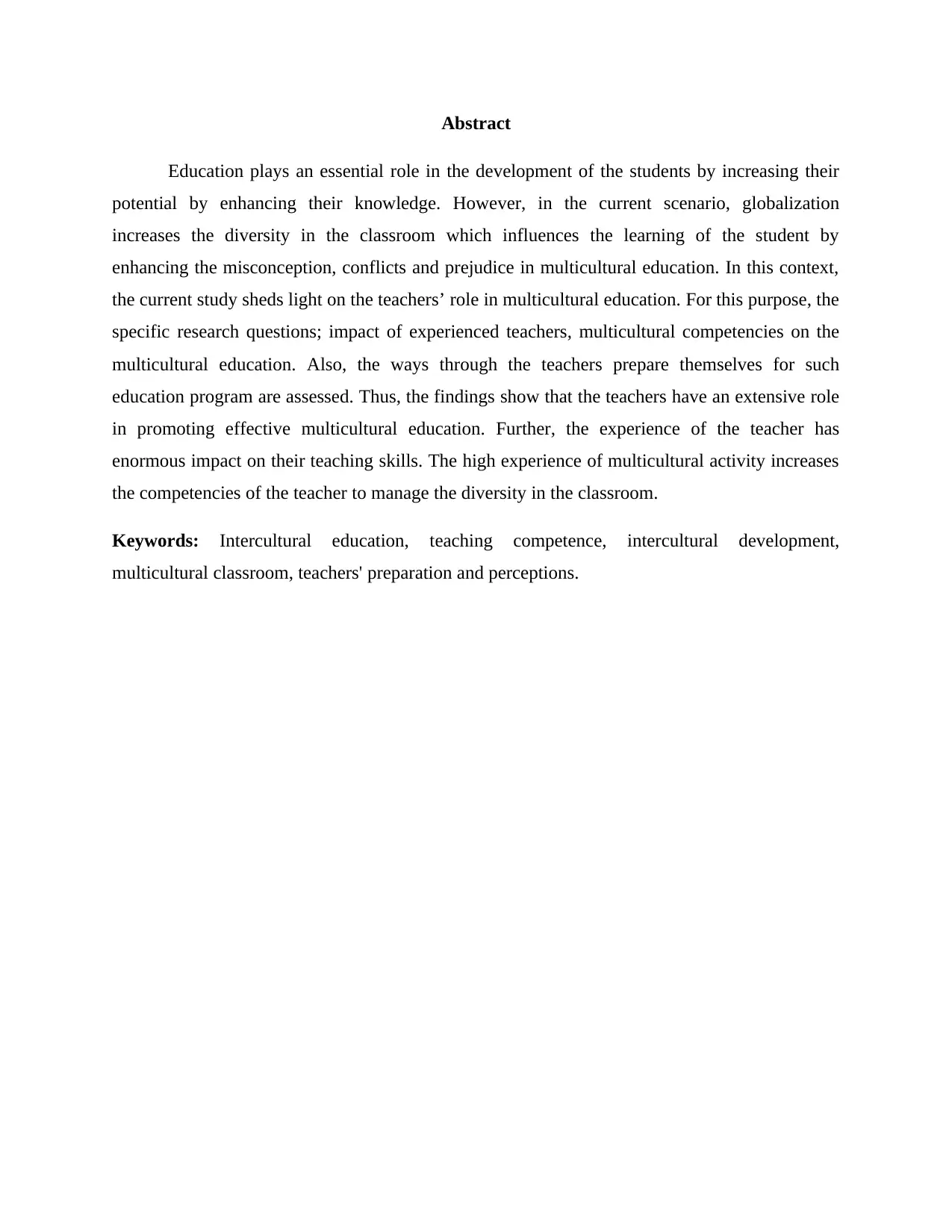
Abstract
Education plays an essential role in the development of the students by increasing their
potential by enhancing their knowledge. However, in the current scenario, globalization
increases the diversity in the classroom which influences the learning of the student by
enhancing the misconception, conflicts and prejudice in multicultural education. In this context,
the current study sheds light on the teachers’ role in multicultural education. For this purpose, the
specific research questions; impact of experienced teachers, multicultural competencies on the
multicultural education. Also, the ways through the teachers prepare themselves for such
education program are assessed. Thus, the findings show that the teachers have an extensive role
in promoting effective multicultural education. Further, the experience of the teacher has
enormous impact on their teaching skills. The high experience of multicultural activity increases
the competencies of the teacher to manage the diversity in the classroom.
Keywords: Intercultural education, teaching competence, intercultural development,
multicultural classroom, teachers' preparation and perceptions.
Education plays an essential role in the development of the students by increasing their
potential by enhancing their knowledge. However, in the current scenario, globalization
increases the diversity in the classroom which influences the learning of the student by
enhancing the misconception, conflicts and prejudice in multicultural education. In this context,
the current study sheds light on the teachers’ role in multicultural education. For this purpose, the
specific research questions; impact of experienced teachers, multicultural competencies on the
multicultural education. Also, the ways through the teachers prepare themselves for such
education program are assessed. Thus, the findings show that the teachers have an extensive role
in promoting effective multicultural education. Further, the experience of the teacher has
enormous impact on their teaching skills. The high experience of multicultural activity increases
the competencies of the teacher to manage the diversity in the classroom.
Keywords: Intercultural education, teaching competence, intercultural development,
multicultural classroom, teachers' preparation and perceptions.

INTRODUCTION
In the emerging trend of international education, the students go beyond the national
boundaries to gain quality education and ensure effective career growth (Powell & Powell,
2015). Further, it enhances the cross-cultural competencies of the student by increasing the
understanding of global culture (Gay, 2013). It enables the student to ensure the rapid growth in
the career with the high chances to gain a valued job. In this regard, the immigration of student
from the home country to another increase the diversity of schools and colleges because the
students are from a different culture (Banks, 2014). Apart from this, the easy immigration
process and mobility motivate the people to live in different countries and take the advantages of
different economies, cultural and institution (Powell & Powell, 2015). Moreover, the extensive
development in technology and telecommunication enhance the connectedness between the
people of a different culture (Gay, 2013). However, it increases the diversity in that particular
country at offices and academic institutes. Therefore, the diversity in educational institutes is
continuously growing which demand effective education through adequate teaching.
The enhancement in academic diversity created several issues which have a significant
impact on the quality of education (Powell & Powell, 2015). This is because students from
different culture increase the chances of conflicts, unfair treatment and prejudice in the
classroom. However, education is imperative to enable the students to accomplish extreme
potentials as an apprentice (Banks, 2014). It increases the demand for the teacher to focus on the
teaching skills to teach the diverse student with the implementation of effective practices. In this
context, the multicultural education promotes the quality of education by reducing the prejudice,
oppression, misconceptions and injustice at the institute (Gollnick & Chinn, 2013). Similarly, for
improving the effective teaching in the multicultural classroom, the cultural empathy and
development of equal opportunity for academic success are significant (Aydin, 2013). It shows
that teaching in diverse classrooms is the most critical task which has a considerable impact on
the academic achievement of the students.
In the current era, the diversity in the classroom is the major issue which influences the
development of the student to a great extent. It also profoundly affects the teachers to achieve
professional success because it has a significant impact on their performance. By understanding
In the emerging trend of international education, the students go beyond the national
boundaries to gain quality education and ensure effective career growth (Powell & Powell,
2015). Further, it enhances the cross-cultural competencies of the student by increasing the
understanding of global culture (Gay, 2013). It enables the student to ensure the rapid growth in
the career with the high chances to gain a valued job. In this regard, the immigration of student
from the home country to another increase the diversity of schools and colleges because the
students are from a different culture (Banks, 2014). Apart from this, the easy immigration
process and mobility motivate the people to live in different countries and take the advantages of
different economies, cultural and institution (Powell & Powell, 2015). Moreover, the extensive
development in technology and telecommunication enhance the connectedness between the
people of a different culture (Gay, 2013). However, it increases the diversity in that particular
country at offices and academic institutes. Therefore, the diversity in educational institutes is
continuously growing which demand effective education through adequate teaching.
The enhancement in academic diversity created several issues which have a significant
impact on the quality of education (Powell & Powell, 2015). This is because students from
different culture increase the chances of conflicts, unfair treatment and prejudice in the
classroom. However, education is imperative to enable the students to accomplish extreme
potentials as an apprentice (Banks, 2014). It increases the demand for the teacher to focus on the
teaching skills to teach the diverse student with the implementation of effective practices. In this
context, the multicultural education promotes the quality of education by reducing the prejudice,
oppression, misconceptions and injustice at the institute (Gollnick & Chinn, 2013). Similarly, for
improving the effective teaching in the multicultural classroom, the cultural empathy and
development of equal opportunity for academic success are significant (Aydin, 2013). It shows
that teaching in diverse classrooms is the most critical task which has a considerable impact on
the academic achievement of the students.
In the current era, the diversity in the classroom is the major issue which influences the
development of the student to a great extent. It also profoundly affects the teachers to achieve
professional success because it has a significant impact on their performance. By understanding
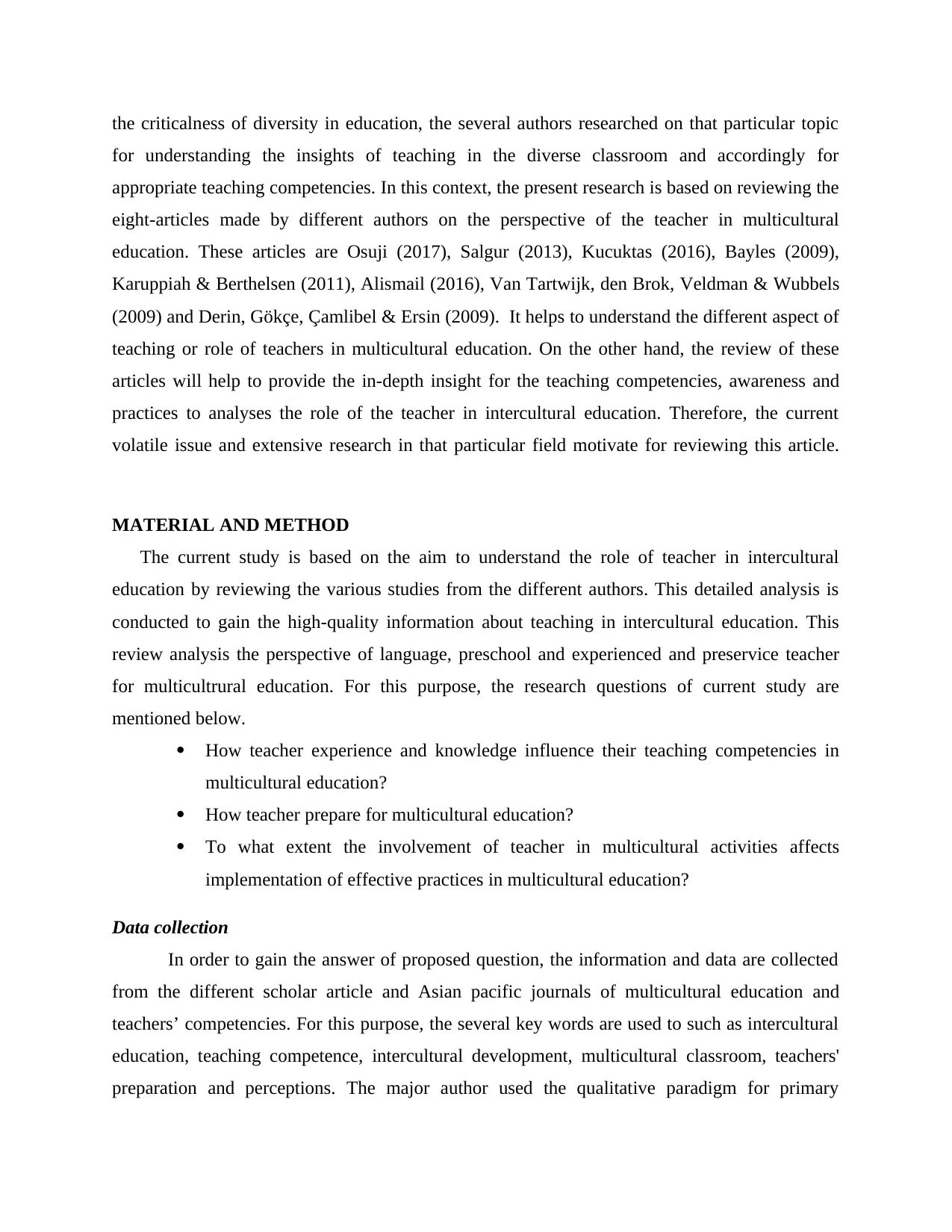
the criticalness of diversity in education, the several authors researched on that particular topic
for understanding the insights of teaching in the diverse classroom and accordingly for
appropriate teaching competencies. In this context, the present research is based on reviewing the
eight-articles made by different authors on the perspective of the teacher in multicultural
education. These articles are Osuji (2017), Salgur (2013), Kucuktas (2016), Bayles (2009),
Karuppiah & Berthelsen (2011), Alismail (2016), Van Tartwijk, den Brok, Veldman & Wubbels
(2009) and Derin, Gökçe, Çamlibel & Ersin (2009). It helps to understand the different aspect of
teaching or role of teachers in multicultural education. On the other hand, the review of these
articles will help to provide the in-depth insight for the teaching competencies, awareness and
practices to analyses the role of the teacher in intercultural education. Therefore, the current
volatile issue and extensive research in that particular field motivate for reviewing this article.
MATERIAL AND METHOD
The current study is based on the aim to understand the role of teacher in intercultural
education by reviewing the various studies from the different authors. This detailed analysis is
conducted to gain the high-quality information about teaching in intercultural education. This
review analysis the perspective of language, preschool and experienced and preservice teacher
for multicultrural education. For this purpose, the research questions of current study are
mentioned below.
How teacher experience and knowledge influence their teaching competencies in
multicultural education?
How teacher prepare for multicultural education?
To what extent the involvement of teacher in multicultural activities affects
implementation of effective practices in multicultural education?
Data collection
In order to gain the answer of proposed question, the information and data are collected
from the different scholar article and Asian pacific journals of multicultural education and
teachers’ competencies. For this purpose, the several key words are used to such as intercultural
education, teaching competence, intercultural development, multicultural classroom, teachers'
preparation and perceptions. The major author used the qualitative paradigm for primary
for understanding the insights of teaching in the diverse classroom and accordingly for
appropriate teaching competencies. In this context, the present research is based on reviewing the
eight-articles made by different authors on the perspective of the teacher in multicultural
education. These articles are Osuji (2017), Salgur (2013), Kucuktas (2016), Bayles (2009),
Karuppiah & Berthelsen (2011), Alismail (2016), Van Tartwijk, den Brok, Veldman & Wubbels
(2009) and Derin, Gökçe, Çamlibel & Ersin (2009). It helps to understand the different aspect of
teaching or role of teachers in multicultural education. On the other hand, the review of these
articles will help to provide the in-depth insight for the teaching competencies, awareness and
practices to analyses the role of the teacher in intercultural education. Therefore, the current
volatile issue and extensive research in that particular field motivate for reviewing this article.
MATERIAL AND METHOD
The current study is based on the aim to understand the role of teacher in intercultural
education by reviewing the various studies from the different authors. This detailed analysis is
conducted to gain the high-quality information about teaching in intercultural education. This
review analysis the perspective of language, preschool and experienced and preservice teacher
for multicultrural education. For this purpose, the research questions of current study are
mentioned below.
How teacher experience and knowledge influence their teaching competencies in
multicultural education?
How teacher prepare for multicultural education?
To what extent the involvement of teacher in multicultural activities affects
implementation of effective practices in multicultural education?
Data collection
In order to gain the answer of proposed question, the information and data are collected
from the different scholar article and Asian pacific journals of multicultural education and
teachers’ competencies. For this purpose, the several key words are used to such as intercultural
education, teaching competence, intercultural development, multicultural classroom, teachers'
preparation and perceptions. The major author used the qualitative paradigm for primary
Secure Best Marks with AI Grader
Need help grading? Try our AI Grader for instant feedback on your assignments.
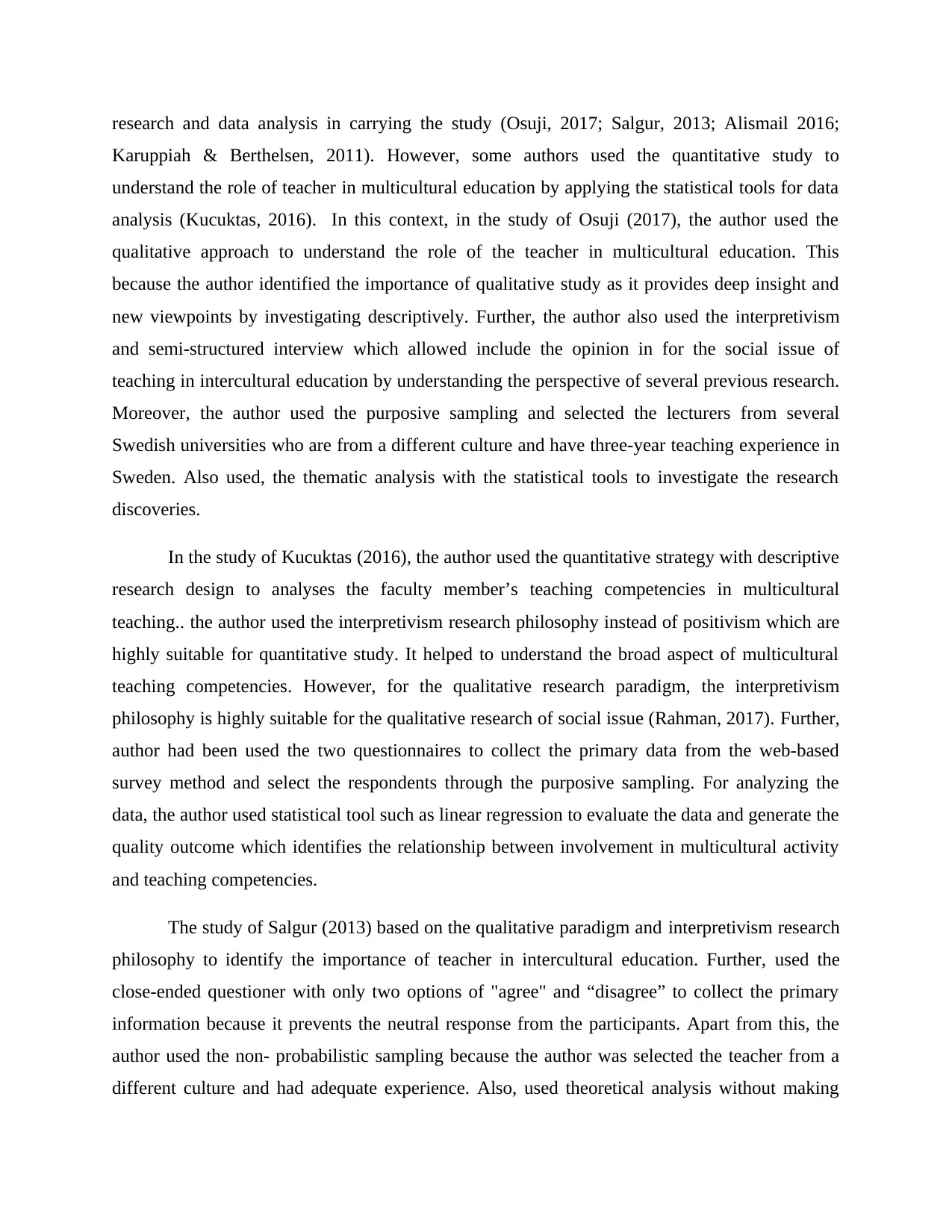
research and data analysis in carrying the study (Osuji, 2017; Salgur, 2013; Alismail 2016;
Karuppiah & Berthelsen, 2011). However, some authors used the quantitative study to
understand the role of teacher in multicultural education by applying the statistical tools for data
analysis (Kucuktas, 2016). In this context, in the study of Osuji (2017), the author used the
qualitative approach to understand the role of the teacher in multicultural education. This
because the author identified the importance of qualitative study as it provides deep insight and
new viewpoints by investigating descriptively. Further, the author also used the interpretivism
and semi-structured interview which allowed include the opinion in for the social issue of
teaching in intercultural education by understanding the perspective of several previous research.
Moreover, the author used the purposive sampling and selected the lecturers from several
Swedish universities who are from a different culture and have three-year teaching experience in
Sweden. Also used, the thematic analysis with the statistical tools to investigate the research
discoveries.
In the study of Kucuktas (2016), the author used the quantitative strategy with descriptive
research design to analyses the faculty member’s teaching competencies in multicultural
teaching.. the author used the interpretivism research philosophy instead of positivism which are
highly suitable for quantitative study. It helped to understand the broad aspect of multicultural
teaching competencies. However, for the qualitative research paradigm, the interpretivism
philosophy is highly suitable for the qualitative research of social issue (Rahman, 2017). Further,
author had been used the two questionnaires to collect the primary data from the web-based
survey method and select the respondents through the purposive sampling. For analyzing the
data, the author used statistical tool such as linear regression to evaluate the data and generate the
quality outcome which identifies the relationship between involvement in multicultural activity
and teaching competencies.
The study of Salgur (2013) based on the qualitative paradigm and interpretivism research
philosophy to identify the importance of teacher in intercultural education. Further, used the
close-ended questioner with only two options of "agree" and “disagree” to collect the primary
information because it prevents the neutral response from the participants. Apart from this, the
author used the non- probabilistic sampling because the author was selected the teacher from a
different culture and had adequate experience. Also, used theoretical analysis without making
Karuppiah & Berthelsen, 2011). However, some authors used the quantitative study to
understand the role of teacher in multicultural education by applying the statistical tools for data
analysis (Kucuktas, 2016). In this context, in the study of Osuji (2017), the author used the
qualitative approach to understand the role of the teacher in multicultural education. This
because the author identified the importance of qualitative study as it provides deep insight and
new viewpoints by investigating descriptively. Further, the author also used the interpretivism
and semi-structured interview which allowed include the opinion in for the social issue of
teaching in intercultural education by understanding the perspective of several previous research.
Moreover, the author used the purposive sampling and selected the lecturers from several
Swedish universities who are from a different culture and have three-year teaching experience in
Sweden. Also used, the thematic analysis with the statistical tools to investigate the research
discoveries.
In the study of Kucuktas (2016), the author used the quantitative strategy with descriptive
research design to analyses the faculty member’s teaching competencies in multicultural
teaching.. the author used the interpretivism research philosophy instead of positivism which are
highly suitable for quantitative study. It helped to understand the broad aspect of multicultural
teaching competencies. However, for the qualitative research paradigm, the interpretivism
philosophy is highly suitable for the qualitative research of social issue (Rahman, 2017). Further,
author had been used the two questionnaires to collect the primary data from the web-based
survey method and select the respondents through the purposive sampling. For analyzing the
data, the author used statistical tool such as linear regression to evaluate the data and generate the
quality outcome which identifies the relationship between involvement in multicultural activity
and teaching competencies.
The study of Salgur (2013) based on the qualitative paradigm and interpretivism research
philosophy to identify the importance of teacher in intercultural education. Further, used the
close-ended questioner with only two options of "agree" and “disagree” to collect the primary
information because it prevents the neutral response from the participants. Apart from this, the
author used the non- probabilistic sampling because the author was selected the teacher from a
different culture and had adequate experience. Also, used theoretical analysis without making
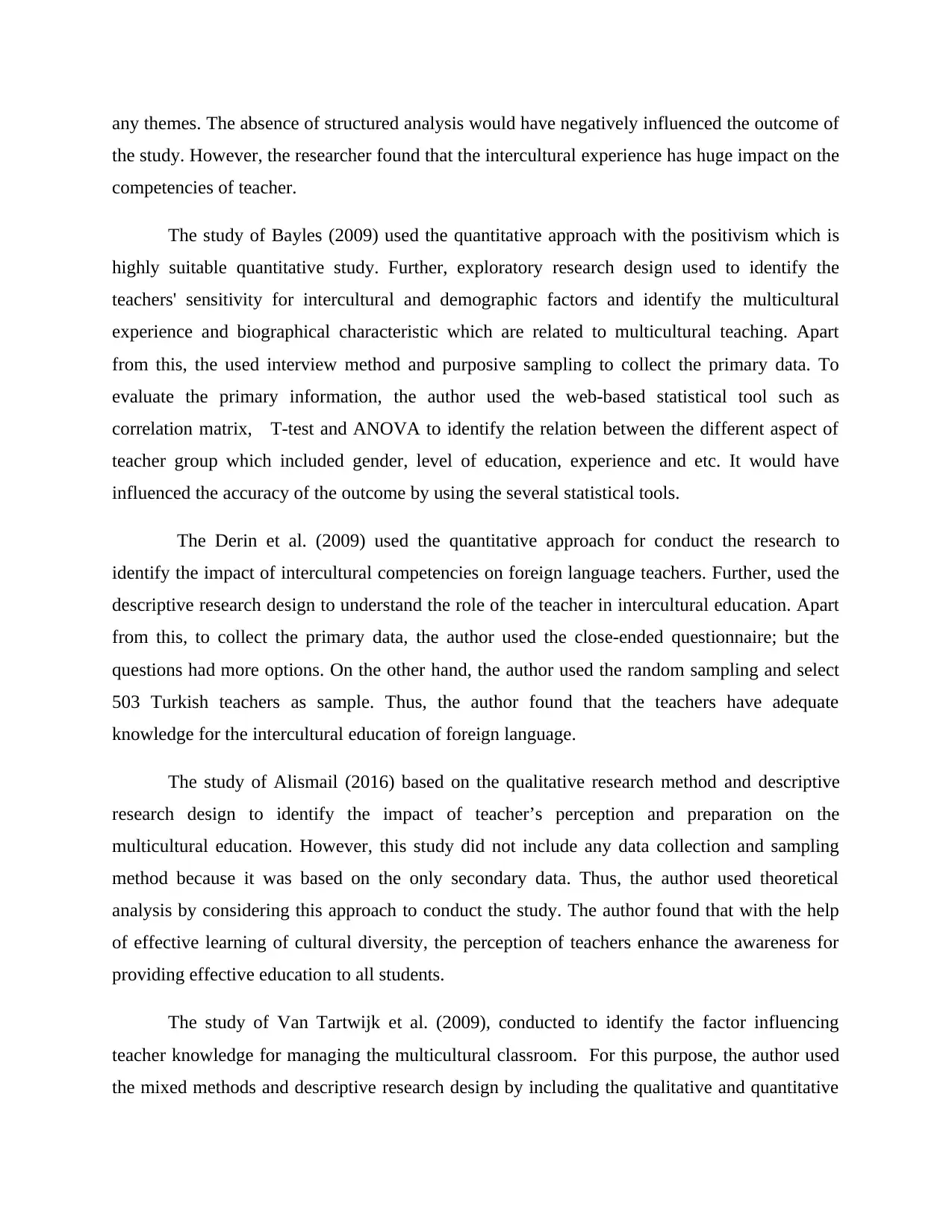
any themes. The absence of structured analysis would have negatively influenced the outcome of
the study. However, the researcher found that the intercultural experience has huge impact on the
competencies of teacher.
The study of Bayles (2009) used the quantitative approach with the positivism which is
highly suitable quantitative study. Further, exploratory research design used to identify the
teachers' sensitivity for intercultural and demographic factors and identify the multicultural
experience and biographical characteristic which are related to multicultural teaching. Apart
from this, the used interview method and purposive sampling to collect the primary data. To
evaluate the primary information, the author used the web-based statistical tool such as
correlation matrix, T-test and ANOVA to identify the relation between the different aspect of
teacher group which included gender, level of education, experience and etc. It would have
influenced the accuracy of the outcome by using the several statistical tools.
The Derin et al. (2009) used the quantitative approach for conduct the research to
identify the impact of intercultural competencies on foreign language teachers. Further, used the
descriptive research design to understand the role of the teacher in intercultural education. Apart
from this, to collect the primary data, the author used the close-ended questionnaire; but the
questions had more options. On the other hand, the author used the random sampling and select
503 Turkish teachers as sample. Thus, the author found that the teachers have adequate
knowledge for the intercultural education of foreign language.
The study of Alismail (2016) based on the qualitative research method and descriptive
research design to identify the impact of teacher’s perception and preparation on the
multicultural education. However, this study did not include any data collection and sampling
method because it was based on the only secondary data. Thus, the author used theoretical
analysis by considering this approach to conduct the study. The author found that with the help
of effective learning of cultural diversity, the perception of teachers enhance the awareness for
providing effective education to all students.
The study of Van Tartwijk et al. (2009), conducted to identify the factor influencing
teacher knowledge for managing the multicultural classroom. For this purpose, the author used
the mixed methods and descriptive research design by including the qualitative and quantitative
the study. However, the researcher found that the intercultural experience has huge impact on the
competencies of teacher.
The study of Bayles (2009) used the quantitative approach with the positivism which is
highly suitable quantitative study. Further, exploratory research design used to identify the
teachers' sensitivity for intercultural and demographic factors and identify the multicultural
experience and biographical characteristic which are related to multicultural teaching. Apart
from this, the used interview method and purposive sampling to collect the primary data. To
evaluate the primary information, the author used the web-based statistical tool such as
correlation matrix, T-test and ANOVA to identify the relation between the different aspect of
teacher group which included gender, level of education, experience and etc. It would have
influenced the accuracy of the outcome by using the several statistical tools.
The Derin et al. (2009) used the quantitative approach for conduct the research to
identify the impact of intercultural competencies on foreign language teachers. Further, used the
descriptive research design to understand the role of the teacher in intercultural education. Apart
from this, to collect the primary data, the author used the close-ended questionnaire; but the
questions had more options. On the other hand, the author used the random sampling and select
503 Turkish teachers as sample. Thus, the author found that the teachers have adequate
knowledge for the intercultural education of foreign language.
The study of Alismail (2016) based on the qualitative research method and descriptive
research design to identify the impact of teacher’s perception and preparation on the
multicultural education. However, this study did not include any data collection and sampling
method because it was based on the only secondary data. Thus, the author used theoretical
analysis by considering this approach to conduct the study. The author found that with the help
of effective learning of cultural diversity, the perception of teachers enhance the awareness for
providing effective education to all students.
The study of Van Tartwijk et al. (2009), conducted to identify the factor influencing
teacher knowledge for managing the multicultural classroom. For this purpose, the author used
the mixed methods and descriptive research design by including the qualitative and quantitative

research choice. Further, the author used the video simulated interview to collect the primary
data. Apart from this, the author used the thematic analysis to evaluate the primary information
and found that the aim of the teacher to creating effective relationship with the students and to
anticipate the student response adjust their teaching method.
The styudy of Karuppiah & Berthelsen (2011) was based on the qualitative research and
exploratory research deign to analyses the understandings of preschool teachers for multicultural
education in Singapore. For this purpose, the author used the survey method with open-ended
questionnaire and purposive sampling to collect the primary data form the 58 female preschool
teacher who have experience more than three years teaching experience in multicultural
education. Apart from this, to evaluate the primary data, the thematic analysis used by the author
which found that the preschool teachers have positive attitude for multicultural education but
they are not aware of the related challenges.
DATA ANALYSIS
As per the analysis of selected articles, this section assessed the findings according to
research question as experience and knowledge of teacher and its impact on the multicultural
education. The analysis has been carried out on the basis of selected articles and findings of the
reviewed articles have been selected as the base of findings of the current study
In this context, the findings of the study of Kucuktas (2016) shows that multicultural
activity enhances the multicultural teaching competencies of the teacher. The study of Kucuktas
(2016) conducted in Auburn city of Alabama county in the US and its finding fulfills the
research aim which is “to examine the multicultural teaching competencies of faculty members
with regard to their multicultural teaching knowledge and skill” and the relation between the
multicultural teaching competencies, experiential and demographic aspect of the teacher. For this
purpose, Kucuktas (2016) used Sue model of cultural competencies, intercultural competencies
model and multicultural teaching competencies scale to assessing the importance of multicultural
competencies for a teacher In the same manner, the study of Salgur (2013) revealed that the
experience of teaching in international school enhance the teachers’ competencies to deal with
the education of diverse student effectively. Both studies revealed the same outcome which is
focused on enhancing the teachers' competencies by involving them into multicultural activities.
However, the study of Karuppiah & Berthelsen (2011) revealed that the major part of teachers
data. Apart from this, the author used the thematic analysis to evaluate the primary information
and found that the aim of the teacher to creating effective relationship with the students and to
anticipate the student response adjust their teaching method.
The styudy of Karuppiah & Berthelsen (2011) was based on the qualitative research and
exploratory research deign to analyses the understandings of preschool teachers for multicultural
education in Singapore. For this purpose, the author used the survey method with open-ended
questionnaire and purposive sampling to collect the primary data form the 58 female preschool
teacher who have experience more than three years teaching experience in multicultural
education. Apart from this, to evaluate the primary data, the thematic analysis used by the author
which found that the preschool teachers have positive attitude for multicultural education but
they are not aware of the related challenges.
DATA ANALYSIS
As per the analysis of selected articles, this section assessed the findings according to
research question as experience and knowledge of teacher and its impact on the multicultural
education. The analysis has been carried out on the basis of selected articles and findings of the
reviewed articles have been selected as the base of findings of the current study
In this context, the findings of the study of Kucuktas (2016) shows that multicultural
activity enhances the multicultural teaching competencies of the teacher. The study of Kucuktas
(2016) conducted in Auburn city of Alabama county in the US and its finding fulfills the
research aim which is “to examine the multicultural teaching competencies of faculty members
with regard to their multicultural teaching knowledge and skill” and the relation between the
multicultural teaching competencies, experiential and demographic aspect of the teacher. For this
purpose, Kucuktas (2016) used Sue model of cultural competencies, intercultural competencies
model and multicultural teaching competencies scale to assessing the importance of multicultural
competencies for a teacher In the same manner, the study of Salgur (2013) revealed that the
experience of teaching in international school enhance the teachers’ competencies to deal with
the education of diverse student effectively. Both studies revealed the same outcome which is
focused on enhancing the teachers' competencies by involving them into multicultural activities.
However, the study of Karuppiah & Berthelsen (2011) revealed that the major part of teachers
Paraphrase This Document
Need a fresh take? Get an instant paraphrase of this document with our AI Paraphraser
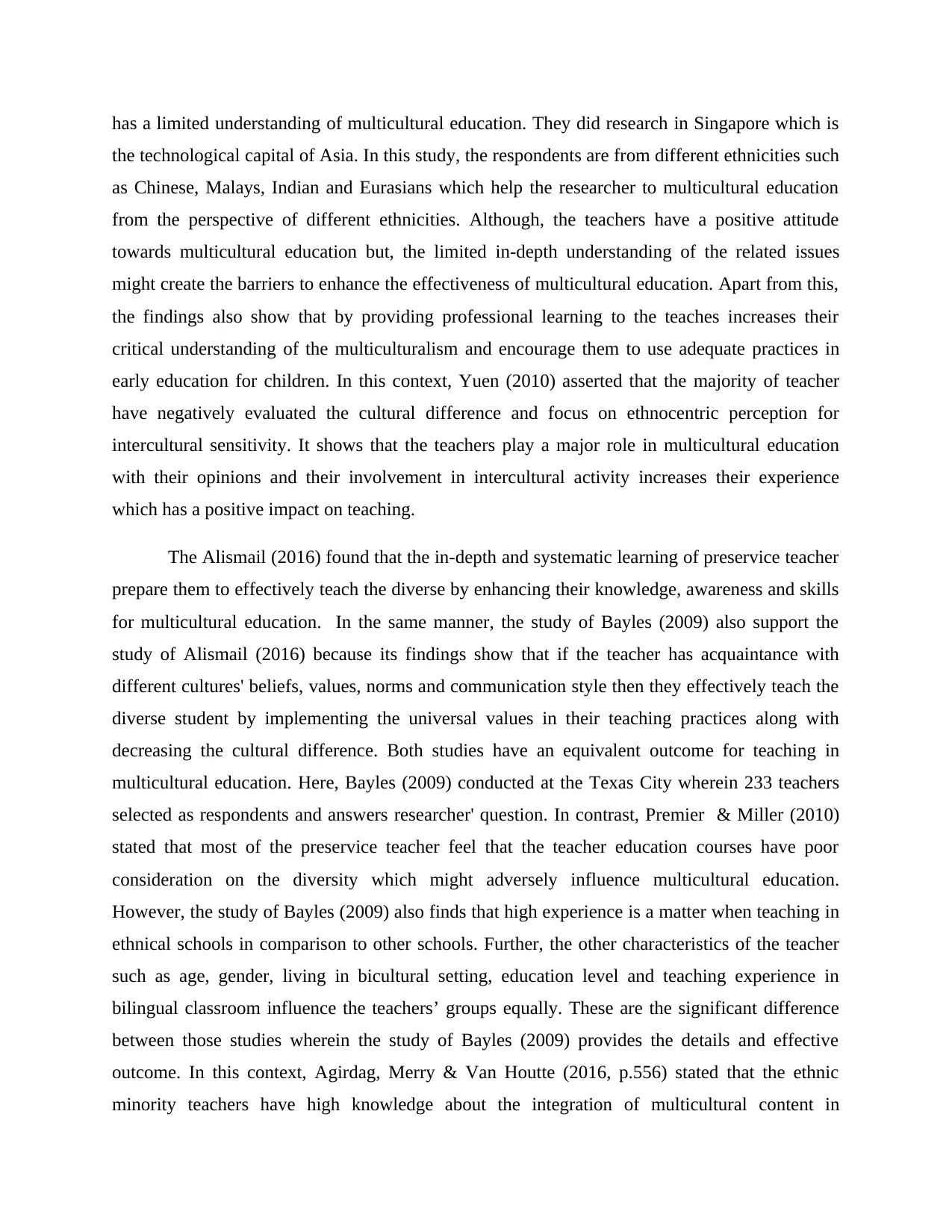
has a limited understanding of multicultural education. They did research in Singapore which is
the technological capital of Asia. In this study, the respondents are from different ethnicities such
as Chinese, Malays, Indian and Eurasians which help the researcher to multicultural education
from the perspective of different ethnicities. Although, the teachers have a positive attitude
towards multicultural education but, the limited in-depth understanding of the related issues
might create the barriers to enhance the effectiveness of multicultural education. Apart from this,
the findings also show that by providing professional learning to the teaches increases their
critical understanding of the multiculturalism and encourage them to use adequate practices in
early education for children. In this context, Yuen (2010) asserted that the majority of teacher
have negatively evaluated the cultural difference and focus on ethnocentric perception for
intercultural sensitivity. It shows that the teachers play a major role in multicultural education
with their opinions and their involvement in intercultural activity increases their experience
which has a positive impact on teaching.
The Alismail (2016) found that the in-depth and systematic learning of preservice teacher
prepare them to effectively teach the diverse by enhancing their knowledge, awareness and skills
for multicultural education. In the same manner, the study of Bayles (2009) also support the
study of Alismail (2016) because its findings show that if the teacher has acquaintance with
different cultures' beliefs, values, norms and communication style then they effectively teach the
diverse student by implementing the universal values in their teaching practices along with
decreasing the cultural difference. Both studies have an equivalent outcome for teaching in
multicultural education. Here, Bayles (2009) conducted at the Texas City wherein 233 teachers
selected as respondents and answers researcher' question. In contrast, Premier & Miller (2010)
stated that most of the preservice teacher feel that the teacher education courses have poor
consideration on the diversity which might adversely influence multicultural education.
However, the study of Bayles (2009) also finds that high experience is a matter when teaching in
ethnical schools in comparison to other schools. Further, the other characteristics of the teacher
such as age, gender, living in bicultural setting, education level and teaching experience in
bilingual classroom influence the teachers’ groups equally. These are the significant difference
between those studies wherein the study of Bayles (2009) provides the details and effective
outcome. In this context, Agirdag, Merry & Van Houtte (2016, p.556) stated that the ethnic
minority teachers have high knowledge about the integration of multicultural content in
the technological capital of Asia. In this study, the respondents are from different ethnicities such
as Chinese, Malays, Indian and Eurasians which help the researcher to multicultural education
from the perspective of different ethnicities. Although, the teachers have a positive attitude
towards multicultural education but, the limited in-depth understanding of the related issues
might create the barriers to enhance the effectiveness of multicultural education. Apart from this,
the findings also show that by providing professional learning to the teaches increases their
critical understanding of the multiculturalism and encourage them to use adequate practices in
early education for children. In this context, Yuen (2010) asserted that the majority of teacher
have negatively evaluated the cultural difference and focus on ethnocentric perception for
intercultural sensitivity. It shows that the teachers play a major role in multicultural education
with their opinions and their involvement in intercultural activity increases their experience
which has a positive impact on teaching.
The Alismail (2016) found that the in-depth and systematic learning of preservice teacher
prepare them to effectively teach the diverse by enhancing their knowledge, awareness and skills
for multicultural education. In the same manner, the study of Bayles (2009) also support the
study of Alismail (2016) because its findings show that if the teacher has acquaintance with
different cultures' beliefs, values, norms and communication style then they effectively teach the
diverse student by implementing the universal values in their teaching practices along with
decreasing the cultural difference. Both studies have an equivalent outcome for teaching in
multicultural education. Here, Bayles (2009) conducted at the Texas City wherein 233 teachers
selected as respondents and answers researcher' question. In contrast, Premier & Miller (2010)
stated that most of the preservice teacher feel that the teacher education courses have poor
consideration on the diversity which might adversely influence multicultural education.
However, the study of Bayles (2009) also finds that high experience is a matter when teaching in
ethnical schools in comparison to other schools. Further, the other characteristics of the teacher
such as age, gender, living in bicultural setting, education level and teaching experience in
bilingual classroom influence the teachers’ groups equally. These are the significant difference
between those studies wherein the study of Bayles (2009) provides the details and effective
outcome. In this context, Agirdag, Merry & Van Houtte (2016, p.556) stated that the ethnic
minority teachers have high knowledge about the integration of multicultural content in

comparison to the local teacher. Further, the public schools and the teachers who work with high
ethnic minorities incorporated multicultural education in comparison to local ethnic schools. The
study of Derin et al. (2009) conducted at Turkey and the respondents were from the different
Turkish regions such as Marmara, Aegean, Mediterranean, Black Sea, Central, Eastern and
Southeastern Anatolia. Its findings revealed that the language teachers have awareness about the
importance of culture in the education of foreign language; however, they do not enhance the
intercrural competencies incorporate the culture in the teaching. Owing to this, these studies do
not support the study of Bayles (2009) by considering the impact of teachers’ characteristics on
multicultural education.
The Osuji (2017) used the theory of globalization and social justice with the detailed
concept of multiculturalism, race, culture and education. Here, the author found that the teacher
gives importance to the cultural difference by considering it for teaching in diverse school.
Further, the values of multicultural education are varied according to different regions. Further,
the author suggested the pedological strategies such as reforming and imparting training to the
teacher to improve their competencies for effective multicultural teaching. In this context,
Karataş & Oral (2015, p. 47) asserted that the education process updates by considering cultural
responsiveness. Further, most of the teacher does not have adequate independence to provide the
culture responsiveness education. At this juncture, the study of Van Tartwijk et al. (2009) found
that the student-teacher relations are most important to fostering an effective atmosphere which
is essential to enhance the effectiveness of multicultural education. Further, the adjustment in
teaching methods is helpful to predict the students’ response. Owing to this, the study of Osuji
(2017) and Van Tartwijk et al. (2009) have quite a similarity by considering the teaching
methods and pedological strategies to improve the teaching in multicultural education.
The Alismail (2016) used theoretical practices which are suggested by previous studies to
prepare the teacher for multicultural education. In the same manner, the other studies also
considered the different theories to understand the role of the teacher in multicultural education
(Van Tartwijk et al. 2009; Karuppiah & Berthelsen, 2011; Derin et al. 2009; Salgur, 2013;
Bayles, 2009). In this context, Maxwell (2010) stated that the use of theories in the research
helps the researcher to develop the ideas by enhancing knowledge of common sense, current
facts and prediction. At this juncture, Davison, Martinsons & Ou (2012) asserted the theories are
ethnic minorities incorporated multicultural education in comparison to local ethnic schools. The
study of Derin et al. (2009) conducted at Turkey and the respondents were from the different
Turkish regions such as Marmara, Aegean, Mediterranean, Black Sea, Central, Eastern and
Southeastern Anatolia. Its findings revealed that the language teachers have awareness about the
importance of culture in the education of foreign language; however, they do not enhance the
intercrural competencies incorporate the culture in the teaching. Owing to this, these studies do
not support the study of Bayles (2009) by considering the impact of teachers’ characteristics on
multicultural education.
The Osuji (2017) used the theory of globalization and social justice with the detailed
concept of multiculturalism, race, culture and education. Here, the author found that the teacher
gives importance to the cultural difference by considering it for teaching in diverse school.
Further, the values of multicultural education are varied according to different regions. Further,
the author suggested the pedological strategies such as reforming and imparting training to the
teacher to improve their competencies for effective multicultural teaching. In this context,
Karataş & Oral (2015, p. 47) asserted that the education process updates by considering cultural
responsiveness. Further, most of the teacher does not have adequate independence to provide the
culture responsiveness education. At this juncture, the study of Van Tartwijk et al. (2009) found
that the student-teacher relations are most important to fostering an effective atmosphere which
is essential to enhance the effectiveness of multicultural education. Further, the adjustment in
teaching methods is helpful to predict the students’ response. Owing to this, the study of Osuji
(2017) and Van Tartwijk et al. (2009) have quite a similarity by considering the teaching
methods and pedological strategies to improve the teaching in multicultural education.
The Alismail (2016) used theoretical practices which are suggested by previous studies to
prepare the teacher for multicultural education. In the same manner, the other studies also
considered the different theories to understand the role of the teacher in multicultural education
(Van Tartwijk et al. 2009; Karuppiah & Berthelsen, 2011; Derin et al. 2009; Salgur, 2013;
Bayles, 2009). In this context, Maxwell (2010) stated that the use of theories in the research
helps the researcher to develop the ideas by enhancing knowledge of common sense, current
facts and prediction. At this juncture, Davison, Martinsons & Ou (2012) asserted the theories are
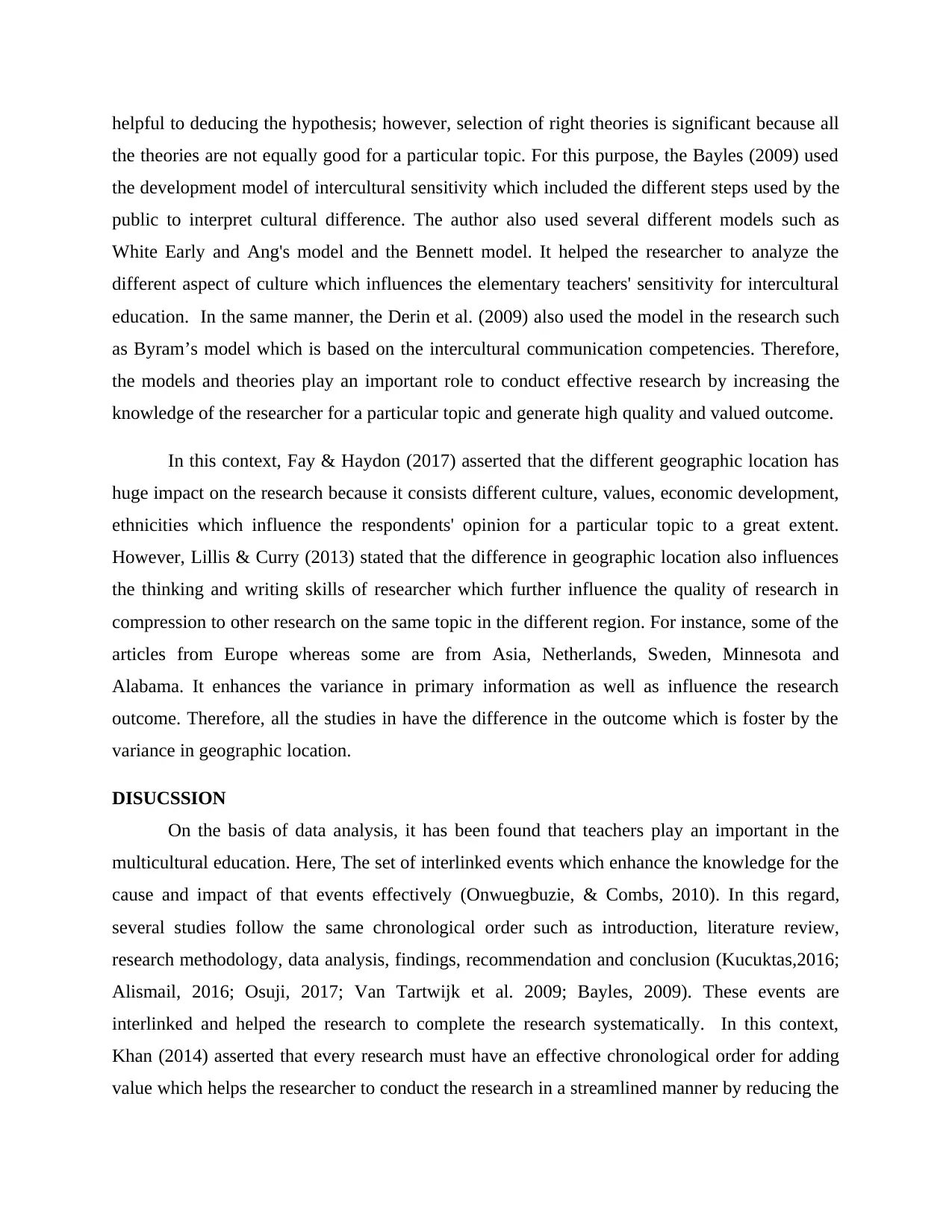
helpful to deducing the hypothesis; however, selection of right theories is significant because all
the theories are not equally good for a particular topic. For this purpose, the Bayles (2009) used
the development model of intercultural sensitivity which included the different steps used by the
public to interpret cultural difference. The author also used several different models such as
White Early and Ang's model and the Bennett model. It helped the researcher to analyze the
different aspect of culture which influences the elementary teachers' sensitivity for intercultural
education. In the same manner, the Derin et al. (2009) also used the model in the research such
as Byram’s model which is based on the intercultural communication competencies. Therefore,
the models and theories play an important role to conduct effective research by increasing the
knowledge of the researcher for a particular topic and generate high quality and valued outcome.
In this context, Fay & Haydon (2017) asserted that the different geographic location has
huge impact on the research because it consists different culture, values, economic development,
ethnicities which influence the respondents' opinion for a particular topic to a great extent.
However, Lillis & Curry (2013) stated that the difference in geographic location also influences
the thinking and writing skills of researcher which further influence the quality of research in
compression to other research on the same topic in the different region. For instance, some of the
articles from Europe whereas some are from Asia, Netherlands, Sweden, Minnesota and
Alabama. It enhances the variance in primary information as well as influence the research
outcome. Therefore, all the studies in have the difference in the outcome which is foster by the
variance in geographic location.
DISUCSSION
On the basis of data analysis, it has been found that teachers play an important in the
multicultural education. Here, The set of interlinked events which enhance the knowledge for the
cause and impact of that events effectively (Onwuegbuzie, & Combs, 2010). In this regard,
several studies follow the same chronological order such as introduction, literature review,
research methodology, data analysis, findings, recommendation and conclusion (Kucuktas,2016;
Alismail, 2016; Osuji, 2017; Van Tartwijk et al. 2009; Bayles, 2009). These events are
interlinked and helped the research to complete the research systematically. In this context,
Khan (2014) asserted that every research must have an effective chronological order for adding
value which helps the researcher to conduct the research in a streamlined manner by reducing the
the theories are not equally good for a particular topic. For this purpose, the Bayles (2009) used
the development model of intercultural sensitivity which included the different steps used by the
public to interpret cultural difference. The author also used several different models such as
White Early and Ang's model and the Bennett model. It helped the researcher to analyze the
different aspect of culture which influences the elementary teachers' sensitivity for intercultural
education. In the same manner, the Derin et al. (2009) also used the model in the research such
as Byram’s model which is based on the intercultural communication competencies. Therefore,
the models and theories play an important role to conduct effective research by increasing the
knowledge of the researcher for a particular topic and generate high quality and valued outcome.
In this context, Fay & Haydon (2017) asserted that the different geographic location has
huge impact on the research because it consists different culture, values, economic development,
ethnicities which influence the respondents' opinion for a particular topic to a great extent.
However, Lillis & Curry (2013) stated that the difference in geographic location also influences
the thinking and writing skills of researcher which further influence the quality of research in
compression to other research on the same topic in the different region. For instance, some of the
articles from Europe whereas some are from Asia, Netherlands, Sweden, Minnesota and
Alabama. It enhances the variance in primary information as well as influence the research
outcome. Therefore, all the studies in have the difference in the outcome which is foster by the
variance in geographic location.
DISUCSSION
On the basis of data analysis, it has been found that teachers play an important in the
multicultural education. Here, The set of interlinked events which enhance the knowledge for the
cause and impact of that events effectively (Onwuegbuzie, & Combs, 2010). In this regard,
several studies follow the same chronological order such as introduction, literature review,
research methodology, data analysis, findings, recommendation and conclusion (Kucuktas,2016;
Alismail, 2016; Osuji, 2017; Van Tartwijk et al. 2009; Bayles, 2009). These events are
interlinked and helped the research to complete the research systematically. In this context,
Khan (2014) asserted that every research must have an effective chronological order for adding
value which helps the researcher to conduct the research in a streamlined manner by reducing the
Secure Best Marks with AI Grader
Need help grading? Try our AI Grader for instant feedback on your assignments.

complexity of research. However, some article has minor difference in chronological order such
as some research miss the literature review whereas some were missing the primary data
collection and analysis (Alismail, 2016; Van Tartwijk et al. 2009). Owing to this, it would have
negatively influenced the researcher to complete the study effective by making the barrier in the
research process. Accordingly, it is imperative for teachers to uphold enough experience in the
same field so that their overall knowledge level will be enhanced this tends to strive on the
learning of students with the cultural differences. This further promote the social justice and
enable students to learn in an effective manner. This leads to derive the valid outcome and ensure
the overall growth of the entire education sector. However, teachers also require appropriate
competencies in orders to provide their services in the multicultural education. Nonetheless, the
globalization, increased diversity and development in the field of education matter a lot which
further stimulate the learning among tutors in order to increase their potential.
The specific order of the research questions which are asked for collecting the primary
data also plays a great role in the effectiveness of research outcome (Khan, 2014). In this
context, the study of Salgur (2013) follows the chronological order for making the
questionnaires. Each question is successively related to the next question which is on next one it
would have helped the researcher to gain the quality information. However, the major
disadvantages of following the chronological order are that if one step is missed in the order the
rest of the activities influences to a great extent (Onwuegbuzie, & Combs, 2010). For this
purpose, the Salgur (2013) put only two option as agree and disagree for giving the answer
which avoids the neutral answer from the respondents and ensures gaining the quality
information. In the same manner, findings reflects that the competencies of teachers has positive
correction with the learning among the students. This is because the expert tutors tends to strives
on the learning of the students by teaching them novel concepts and influencing them for the
continuous learning. This leads to derive the valid outcome and force them to promote the
positive learning. At the same time, the interest level of teachers in the teaching is also crucial
which is highly influenced by their existing knowledge and its contribution in the multicultural
education. Apart from this, the multi-cultural education supports the equality and cultural
diversity. Yet, is it highly affected from the level of teachers involvement in the study or
practices developed in the multicultural education. This demands from institutes and education
sector to ensure the involvement or collaboration with the teachers. This would make it possible
as some research miss the literature review whereas some were missing the primary data
collection and analysis (Alismail, 2016; Van Tartwijk et al. 2009). Owing to this, it would have
negatively influenced the researcher to complete the study effective by making the barrier in the
research process. Accordingly, it is imperative for teachers to uphold enough experience in the
same field so that their overall knowledge level will be enhanced this tends to strive on the
learning of students with the cultural differences. This further promote the social justice and
enable students to learn in an effective manner. This leads to derive the valid outcome and ensure
the overall growth of the entire education sector. However, teachers also require appropriate
competencies in orders to provide their services in the multicultural education. Nonetheless, the
globalization, increased diversity and development in the field of education matter a lot which
further stimulate the learning among tutors in order to increase their potential.
The specific order of the research questions which are asked for collecting the primary
data also plays a great role in the effectiveness of research outcome (Khan, 2014). In this
context, the study of Salgur (2013) follows the chronological order for making the
questionnaires. Each question is successively related to the next question which is on next one it
would have helped the researcher to gain the quality information. However, the major
disadvantages of following the chronological order are that if one step is missed in the order the
rest of the activities influences to a great extent (Onwuegbuzie, & Combs, 2010). For this
purpose, the Salgur (2013) put only two option as agree and disagree for giving the answer
which avoids the neutral answer from the respondents and ensures gaining the quality
information. In the same manner, findings reflects that the competencies of teachers has positive
correction with the learning among the students. This is because the expert tutors tends to strives
on the learning of the students by teaching them novel concepts and influencing them for the
continuous learning. This leads to derive the valid outcome and force them to promote the
positive learning. At the same time, the interest level of teachers in the teaching is also crucial
which is highly influenced by their existing knowledge and its contribution in the multicultural
education. Apart from this, the multi-cultural education supports the equality and cultural
diversity. Yet, is it highly affected from the level of teachers involvement in the study or
practices developed in the multicultural education. This demands from institutes and education
sector to ensure the involvement or collaboration with the teachers. This would make it possible

to set the collaborative practices through which such educational facilities can be promoted in an
effectual manner.
Some of the studies shed light on the role of teachers or their perception in promoting the
effective classroom activities that tends to reduce the cultural issues and promote the learning.
Here, the study of Osuji (2017) also consider the chronological order for making the
questionnaire by dividing it into two part wherein the first part relates to the background of the
teacher whereas the second part related to opinion and strategies of the teacher which foster the
multicultural education. Thus, the effective implementation of chronological order is significant
to enhance the value of research. Owing to this, it has been found that teachers plays an active
role in determining the involvement level of teachers in the education. It is because teachers are
directly connected to the students where they get to know about their perception, viewpoint and
activities and accordingly effective classroom activities can be designed. However, the learning
and training facilities for teachers can be useful in order to increase the positive perception
towards the multicultural education and enabling them to be proactive for multicultural
education. Apart from this, depending on the demand of the place or country, teachers make
themselves prepared for the teaching facilities in the multicultural environment. However, their
learning plays an extensive role whereby their continuous learning can stimulate the growth of
the teacher which in turn promote the education.
The multicultural education is highly influenced by the experience of teacher. Owing to
this, highly experienced teacher can shape the right environment depending on their existing
knowledge. This would also be helpful for particular school or staff to understand the importance
of multicultural education and avoid barriers faced in the same. Owing to this, the association of
more staff members and education related to the same field tends to affect the learning. This
required school or education sector to ensure the inclusion of skilled teachers who are proficient
and skilled. This would promote the learning among students as well as teachers.
CONCLUSION
The multicultural education is significant in addressing multicultural societies. Further, it
helps the teacher to promote social justice and make an effective relationship between the
students and the teacher. Also, extensive knowledge from the research is helpful for the teacher
to teach effectively in multicultural schools. Apart from this, the author suggests that the
effectual manner.
Some of the studies shed light on the role of teachers or their perception in promoting the
effective classroom activities that tends to reduce the cultural issues and promote the learning.
Here, the study of Osuji (2017) also consider the chronological order for making the
questionnaire by dividing it into two part wherein the first part relates to the background of the
teacher whereas the second part related to opinion and strategies of the teacher which foster the
multicultural education. Thus, the effective implementation of chronological order is significant
to enhance the value of research. Owing to this, it has been found that teachers plays an active
role in determining the involvement level of teachers in the education. It is because teachers are
directly connected to the students where they get to know about their perception, viewpoint and
activities and accordingly effective classroom activities can be designed. However, the learning
and training facilities for teachers can be useful in order to increase the positive perception
towards the multicultural education and enabling them to be proactive for multicultural
education. Apart from this, depending on the demand of the place or country, teachers make
themselves prepared for the teaching facilities in the multicultural environment. However, their
learning plays an extensive role whereby their continuous learning can stimulate the growth of
the teacher which in turn promote the education.
The multicultural education is highly influenced by the experience of teacher. Owing to
this, highly experienced teacher can shape the right environment depending on their existing
knowledge. This would also be helpful for particular school or staff to understand the importance
of multicultural education and avoid barriers faced in the same. Owing to this, the association of
more staff members and education related to the same field tends to affect the learning. This
required school or education sector to ensure the inclusion of skilled teachers who are proficient
and skilled. This would promote the learning among students as well as teachers.
CONCLUSION
The multicultural education is significant in addressing multicultural societies. Further, it
helps the teacher to promote social justice and make an effective relationship between the
students and the teacher. Also, extensive knowledge from the research is helpful for the teacher
to teach effectively in multicultural schools. Apart from this, the author suggests that the

globalization, diversity and education are the broad and complex phenomena which cannot
describe to effective from stating to endpoints. Also, the teachers’ awareness for multicultural
education plays the important role. However, the development in their teaching competencies
increase the capabilities for teaching diverse student effectively. Due to this., the teachers should
focus on the enhancement of teaching competencies and can implement effective teaching
practices in the diverse classroom. However, the teachers' interest in developing the multicultural
teaching competencies did not investigate in the studies which create the scope for future
research. However, the greater level of involvement of teachers in the multicultural education
can effectively promote the learning. This is because teachers better understand about the
requirement of students. Nonetheless, the experience of teachers would influence the learning
where they can be able to shape the right strategies. This tends to derive the valid outcome and
support people to explore the new ways of learning that stimulate the diversity and equality.
It can also be concluded that lack of learning facilities among teacher is also one of the
potential barriers through which they might not prepared themselves for the multicultural
education. Owing to this, it is crucial for the education sector to foster learning among teachers.
In this context, the technological advancement and continuous support for teachers can be
fruitful which in turn support the students to a great extent. However, association of expert can
be helpful whereby right strategies are shaped to stimulate the learning and deriving the valid
outcome. This tends to affect the learning of teachers to a great extent. It can also be said that
existing knowledge, potential or competencies of teachers have direct impact on the learning of
students. It is because such experienced teachers are better aware about the potential issues
which might impede the learning. Owing to this, their active efforts can bring the valid outcome
with the association of experts to foster the learning students of different cultures. It is because
the response of students shape their method and accordingly they bring new techniques at the
place to stimulate the learning. This would also be helpful in scheduling the appropriate
classroom activities which in turn increase the competencies of students and also motivate
teachers to bring such innovative learning activities sin the class or overall school.
It is essential for the teacher to understand the multiculturalism which helps them to treat
each student equally for providing the education. Further, the authors interpret that the well-
designed multicultural training is crucial for the teacher to develop the awareness, attitude and
describe to effective from stating to endpoints. Also, the teachers’ awareness for multicultural
education plays the important role. However, the development in their teaching competencies
increase the capabilities for teaching diverse student effectively. Due to this., the teachers should
focus on the enhancement of teaching competencies and can implement effective teaching
practices in the diverse classroom. However, the teachers' interest in developing the multicultural
teaching competencies did not investigate in the studies which create the scope for future
research. However, the greater level of involvement of teachers in the multicultural education
can effectively promote the learning. This is because teachers better understand about the
requirement of students. Nonetheless, the experience of teachers would influence the learning
where they can be able to shape the right strategies. This tends to derive the valid outcome and
support people to explore the new ways of learning that stimulate the diversity and equality.
It can also be concluded that lack of learning facilities among teacher is also one of the
potential barriers through which they might not prepared themselves for the multicultural
education. Owing to this, it is crucial for the education sector to foster learning among teachers.
In this context, the technological advancement and continuous support for teachers can be
fruitful which in turn support the students to a great extent. However, association of expert can
be helpful whereby right strategies are shaped to stimulate the learning and deriving the valid
outcome. This tends to affect the learning of teachers to a great extent. It can also be said that
existing knowledge, potential or competencies of teachers have direct impact on the learning of
students. It is because such experienced teachers are better aware about the potential issues
which might impede the learning. Owing to this, their active efforts can bring the valid outcome
with the association of experts to foster the learning students of different cultures. It is because
the response of students shape their method and accordingly they bring new techniques at the
place to stimulate the learning. This would also be helpful in scheduling the appropriate
classroom activities which in turn increase the competencies of students and also motivate
teachers to bring such innovative learning activities sin the class or overall school.
It is essential for the teacher to understand the multiculturalism which helps them to treat
each student equally for providing the education. Further, the authors interpret that the well-
designed multicultural training is crucial for the teacher to develop the awareness, attitude and
Paraphrase This Document
Need a fresh take? Get an instant paraphrase of this document with our AI Paraphraser
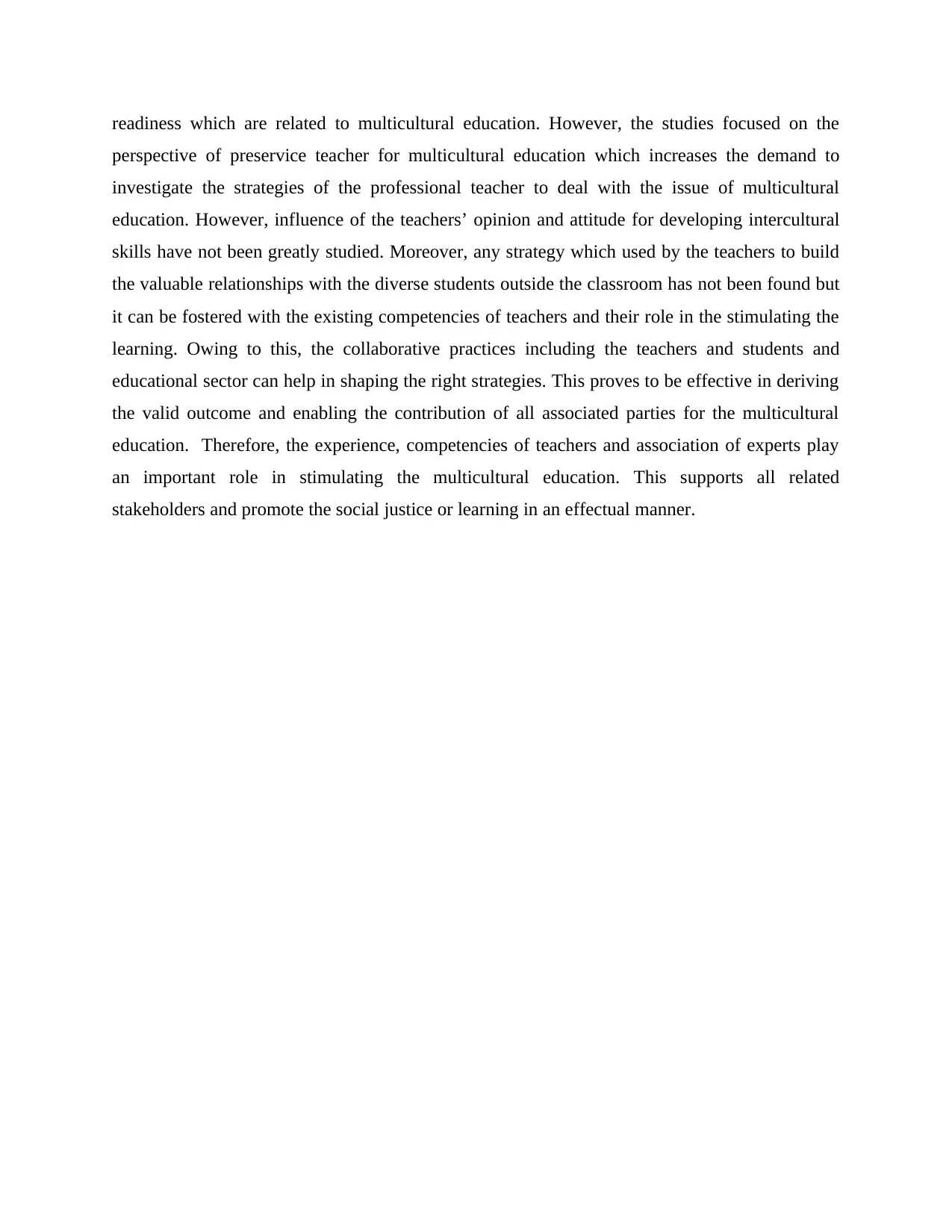
readiness which are related to multicultural education. However, the studies focused on the
perspective of preservice teacher for multicultural education which increases the demand to
investigate the strategies of the professional teacher to deal with the issue of multicultural
education. However, influence of the teachers’ opinion and attitude for developing intercultural
skills have not been greatly studied. Moreover, any strategy which used by the teachers to build
the valuable relationships with the diverse students outside the classroom has not been found but
it can be fostered with the existing competencies of teachers and their role in the stimulating the
learning. Owing to this, the collaborative practices including the teachers and students and
educational sector can help in shaping the right strategies. This proves to be effective in deriving
the valid outcome and enabling the contribution of all associated parties for the multicultural
education. Therefore, the experience, competencies of teachers and association of experts play
an important role in stimulating the multicultural education. This supports all related
stakeholders and promote the social justice or learning in an effectual manner.
perspective of preservice teacher for multicultural education which increases the demand to
investigate the strategies of the professional teacher to deal with the issue of multicultural
education. However, influence of the teachers’ opinion and attitude for developing intercultural
skills have not been greatly studied. Moreover, any strategy which used by the teachers to build
the valuable relationships with the diverse students outside the classroom has not been found but
it can be fostered with the existing competencies of teachers and their role in the stimulating the
learning. Owing to this, the collaborative practices including the teachers and students and
educational sector can help in shaping the right strategies. This proves to be effective in deriving
the valid outcome and enabling the contribution of all associated parties for the multicultural
education. Therefore, the experience, competencies of teachers and association of experts play
an important role in stimulating the multicultural education. This supports all related
stakeholders and promote the social justice or learning in an effectual manner.
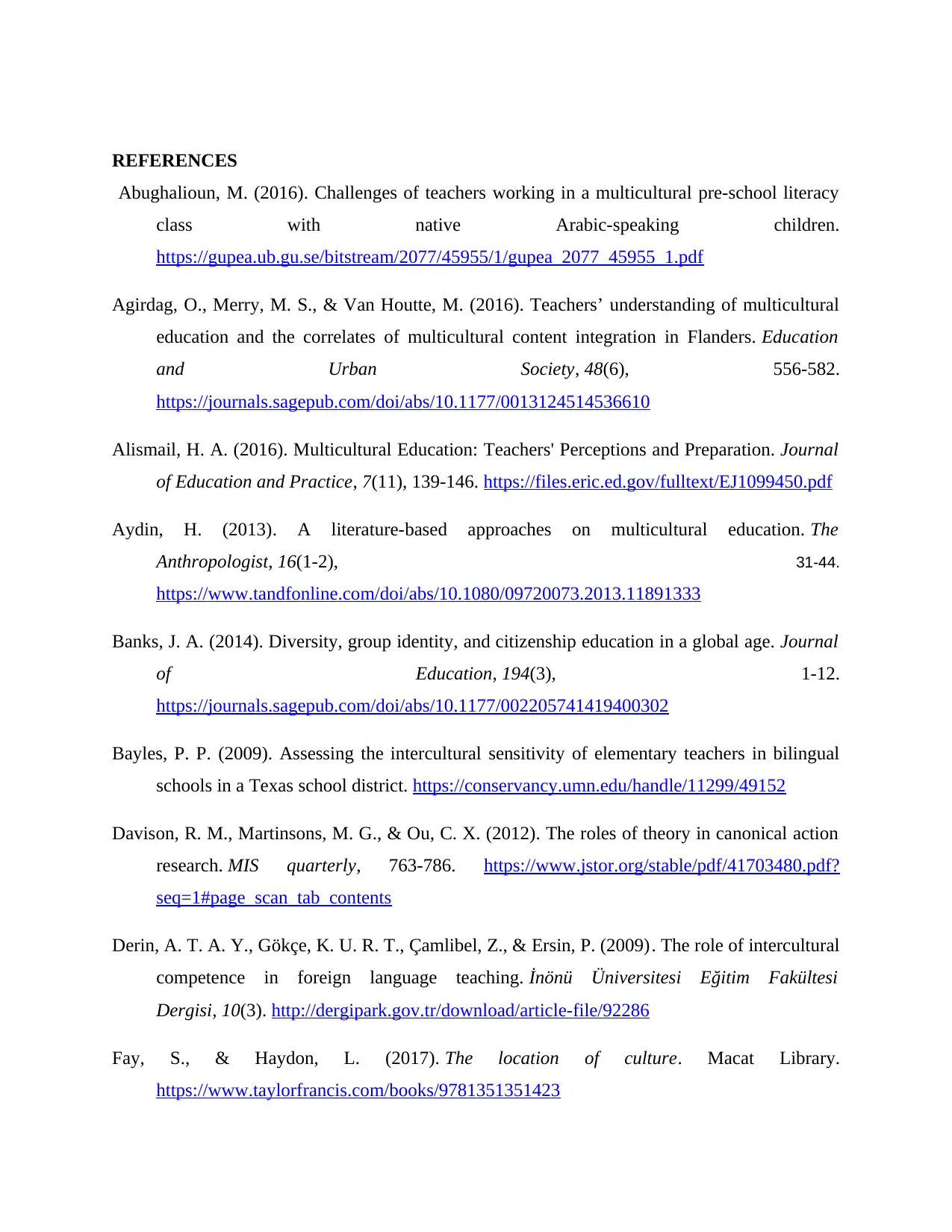
REFERENCES
Abughalioun, M. (2016). Challenges of teachers working in a multicultural pre-school literacy
class with native Arabic-speaking children.
https://gupea.ub.gu.se/bitstream/2077/45955/1/gupea_2077_45955_1.pdf
Agirdag, O., Merry, M. S., & Van Houtte, M. (2016). Teachers’ understanding of multicultural
education and the correlates of multicultural content integration in Flanders. Education
and Urban Society, 48(6), 556-582.
https://journals.sagepub.com/doi/abs/10.1177/0013124514536610
Alismail, H. A. (2016). Multicultural Education: Teachers' Perceptions and Preparation. Journal
of Education and Practice, 7(11), 139-146. https://files.eric.ed.gov/fulltext/EJ1099450.pdf
Aydin, H. (2013). A literature-based approaches on multicultural education. The
Anthropologist, 16(1-2), 31-44.
https://www.tandfonline.com/doi/abs/10.1080/09720073.2013.11891333
Banks, J. A. (2014). Diversity, group identity, and citizenship education in a global age. Journal
of Education, 194(3), 1-12.
https://journals.sagepub.com/doi/abs/10.1177/002205741419400302
Bayles, P. P. (2009). Assessing the intercultural sensitivity of elementary teachers in bilingual
schools in a Texas school district. https://conservancy.umn.edu/handle/11299/49152
Davison, R. M., Martinsons, M. G., & Ou, C. X. (2012). The roles of theory in canonical action
research. MIS quarterly, 763-786. https://www.jstor.org/stable/pdf/41703480.pdf?
seq=1#page_scan_tab_contents
Derin, A. T. A. Y., Gökçe, K. U. R. T., Çamlibel, Z., & Ersin, P. (2009). The role of intercultural
competence in foreign language teaching. İnönü Üniversitesi Eğitim Fakültesi
Dergisi, 10(3). http://dergipark.gov.tr/download/article-file/92286
Fay, S., & Haydon, L. (2017). The location of culture. Macat Library.
https://www.taylorfrancis.com/books/9781351351423
Abughalioun, M. (2016). Challenges of teachers working in a multicultural pre-school literacy
class with native Arabic-speaking children.
https://gupea.ub.gu.se/bitstream/2077/45955/1/gupea_2077_45955_1.pdf
Agirdag, O., Merry, M. S., & Van Houtte, M. (2016). Teachers’ understanding of multicultural
education and the correlates of multicultural content integration in Flanders. Education
and Urban Society, 48(6), 556-582.
https://journals.sagepub.com/doi/abs/10.1177/0013124514536610
Alismail, H. A. (2016). Multicultural Education: Teachers' Perceptions and Preparation. Journal
of Education and Practice, 7(11), 139-146. https://files.eric.ed.gov/fulltext/EJ1099450.pdf
Aydin, H. (2013). A literature-based approaches on multicultural education. The
Anthropologist, 16(1-2), 31-44.
https://www.tandfonline.com/doi/abs/10.1080/09720073.2013.11891333
Banks, J. A. (2014). Diversity, group identity, and citizenship education in a global age. Journal
of Education, 194(3), 1-12.
https://journals.sagepub.com/doi/abs/10.1177/002205741419400302
Bayles, P. P. (2009). Assessing the intercultural sensitivity of elementary teachers in bilingual
schools in a Texas school district. https://conservancy.umn.edu/handle/11299/49152
Davison, R. M., Martinsons, M. G., & Ou, C. X. (2012). The roles of theory in canonical action
research. MIS quarterly, 763-786. https://www.jstor.org/stable/pdf/41703480.pdf?
seq=1#page_scan_tab_contents
Derin, A. T. A. Y., Gökçe, K. U. R. T., Çamlibel, Z., & Ersin, P. (2009). The role of intercultural
competence in foreign language teaching. İnönü Üniversitesi Eğitim Fakültesi
Dergisi, 10(3). http://dergipark.gov.tr/download/article-file/92286
Fay, S., & Haydon, L. (2017). The location of culture. Macat Library.
https://www.taylorfrancis.com/books/9781351351423
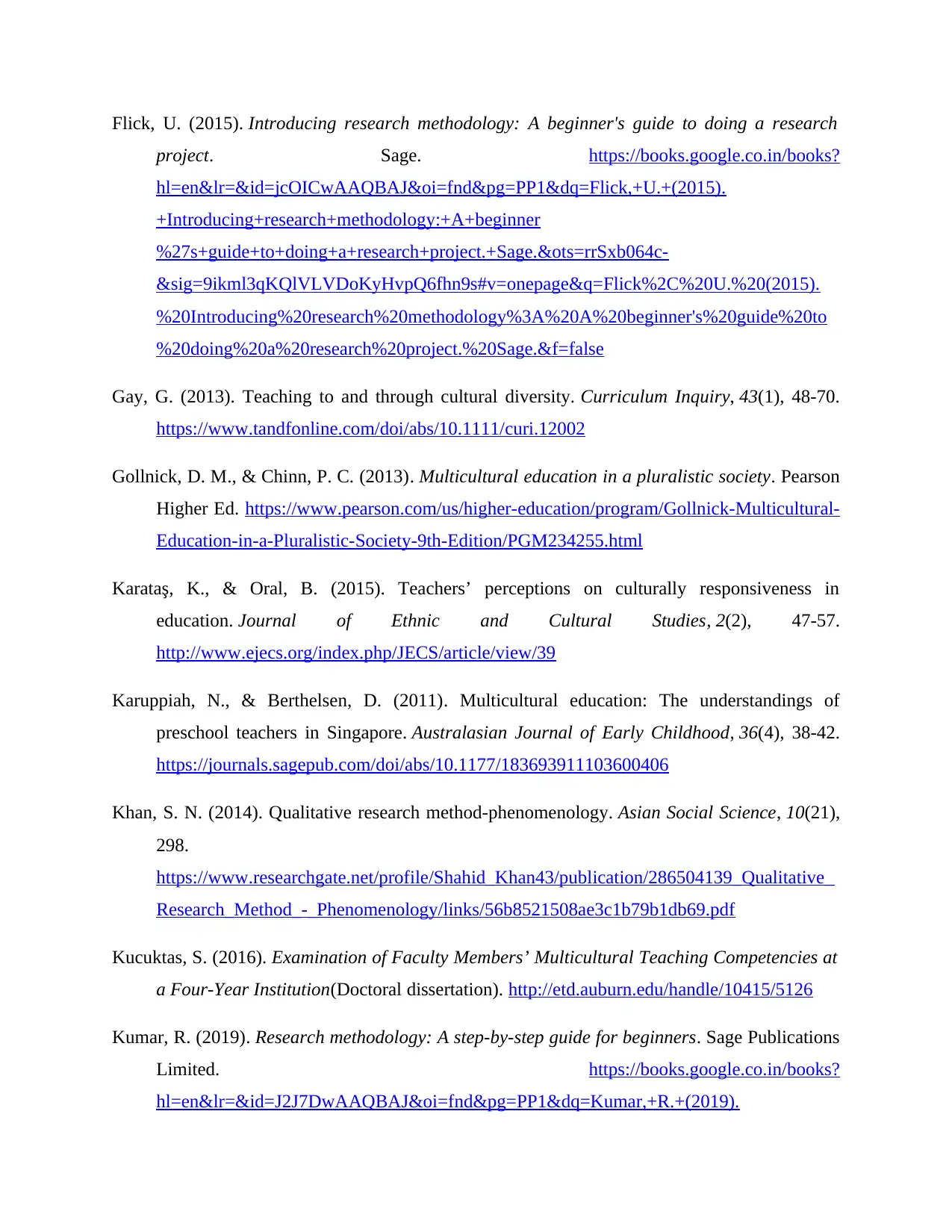
Flick, U. (2015). Introducing research methodology: A beginner's guide to doing a research
project. Sage. https://books.google.co.in/books?
hl=en&lr=&id=jcOICwAAQBAJ&oi=fnd&pg=PP1&dq=Flick,+U.+(2015).
+Introducing+research+methodology:+A+beginner
%27s+guide+to+doing+a+research+project.+Sage.&ots=rrSxb064c-
&sig=9ikml3qKQlVLVDoKyHvpQ6fhn9s#v=onepage&q=Flick%2C%20U.%20(2015).
%20Introducing%20research%20methodology%3A%20A%20beginner's%20guide%20to
%20doing%20a%20research%20project.%20Sage.&f=false
Gay, G. (2013). Teaching to and through cultural diversity. Curriculum Inquiry, 43(1), 48-70.
https://www.tandfonline.com/doi/abs/10.1111/curi.12002
Gollnick, D. M., & Chinn, P. C. (2013). Multicultural education in a pluralistic society. Pearson
Higher Ed. https://www.pearson.com/us/higher-education/program/Gollnick-Multicultural-
Education-in-a-Pluralistic-Society-9th-Edition/PGM234255.html
Karataş, K., & Oral, B. (2015). Teachers’ perceptions on culturally responsiveness in
education. Journal of Ethnic and Cultural Studies, 2(2), 47-57.
http://www.ejecs.org/index.php/JECS/article/view/39
Karuppiah, N., & Berthelsen, D. (2011). Multicultural education: The understandings of
preschool teachers in Singapore. Australasian Journal of Early Childhood, 36(4), 38-42.
https://journals.sagepub.com/doi/abs/10.1177/183693911103600406
Khan, S. N. (2014). Qualitative research method-phenomenology. Asian Social Science, 10(21),
298.
https://www.researchgate.net/profile/Shahid_Khan43/publication/286504139_Qualitative_
Research_Method_-_Phenomenology/links/56b8521508ae3c1b79b1db69.pdf
Kucuktas, S. (2016). Examination of Faculty Members’ Multicultural Teaching Competencies at
a Four-Year Institution(Doctoral dissertation). http://etd.auburn.edu/handle/10415/5126
Kumar, R. (2019). Research methodology: A step-by-step guide for beginners. Sage Publications
Limited. https://books.google.co.in/books?
hl=en&lr=&id=J2J7DwAAQBAJ&oi=fnd&pg=PP1&dq=Kumar,+R.+(2019).
project. Sage. https://books.google.co.in/books?
hl=en&lr=&id=jcOICwAAQBAJ&oi=fnd&pg=PP1&dq=Flick,+U.+(2015).
+Introducing+research+methodology:+A+beginner
%27s+guide+to+doing+a+research+project.+Sage.&ots=rrSxb064c-
&sig=9ikml3qKQlVLVDoKyHvpQ6fhn9s#v=onepage&q=Flick%2C%20U.%20(2015).
%20Introducing%20research%20methodology%3A%20A%20beginner's%20guide%20to
%20doing%20a%20research%20project.%20Sage.&f=false
Gay, G. (2013). Teaching to and through cultural diversity. Curriculum Inquiry, 43(1), 48-70.
https://www.tandfonline.com/doi/abs/10.1111/curi.12002
Gollnick, D. M., & Chinn, P. C. (2013). Multicultural education in a pluralistic society. Pearson
Higher Ed. https://www.pearson.com/us/higher-education/program/Gollnick-Multicultural-
Education-in-a-Pluralistic-Society-9th-Edition/PGM234255.html
Karataş, K., & Oral, B. (2015). Teachers’ perceptions on culturally responsiveness in
education. Journal of Ethnic and Cultural Studies, 2(2), 47-57.
http://www.ejecs.org/index.php/JECS/article/view/39
Karuppiah, N., & Berthelsen, D. (2011). Multicultural education: The understandings of
preschool teachers in Singapore. Australasian Journal of Early Childhood, 36(4), 38-42.
https://journals.sagepub.com/doi/abs/10.1177/183693911103600406
Khan, S. N. (2014). Qualitative research method-phenomenology. Asian Social Science, 10(21),
298.
https://www.researchgate.net/profile/Shahid_Khan43/publication/286504139_Qualitative_
Research_Method_-_Phenomenology/links/56b8521508ae3c1b79b1db69.pdf
Kucuktas, S. (2016). Examination of Faculty Members’ Multicultural Teaching Competencies at
a Four-Year Institution(Doctoral dissertation). http://etd.auburn.edu/handle/10415/5126
Kumar, R. (2019). Research methodology: A step-by-step guide for beginners. Sage Publications
Limited. https://books.google.co.in/books?
hl=en&lr=&id=J2J7DwAAQBAJ&oi=fnd&pg=PP1&dq=Kumar,+R.+(2019).
Secure Best Marks with AI Grader
Need help grading? Try our AI Grader for instant feedback on your assignments.
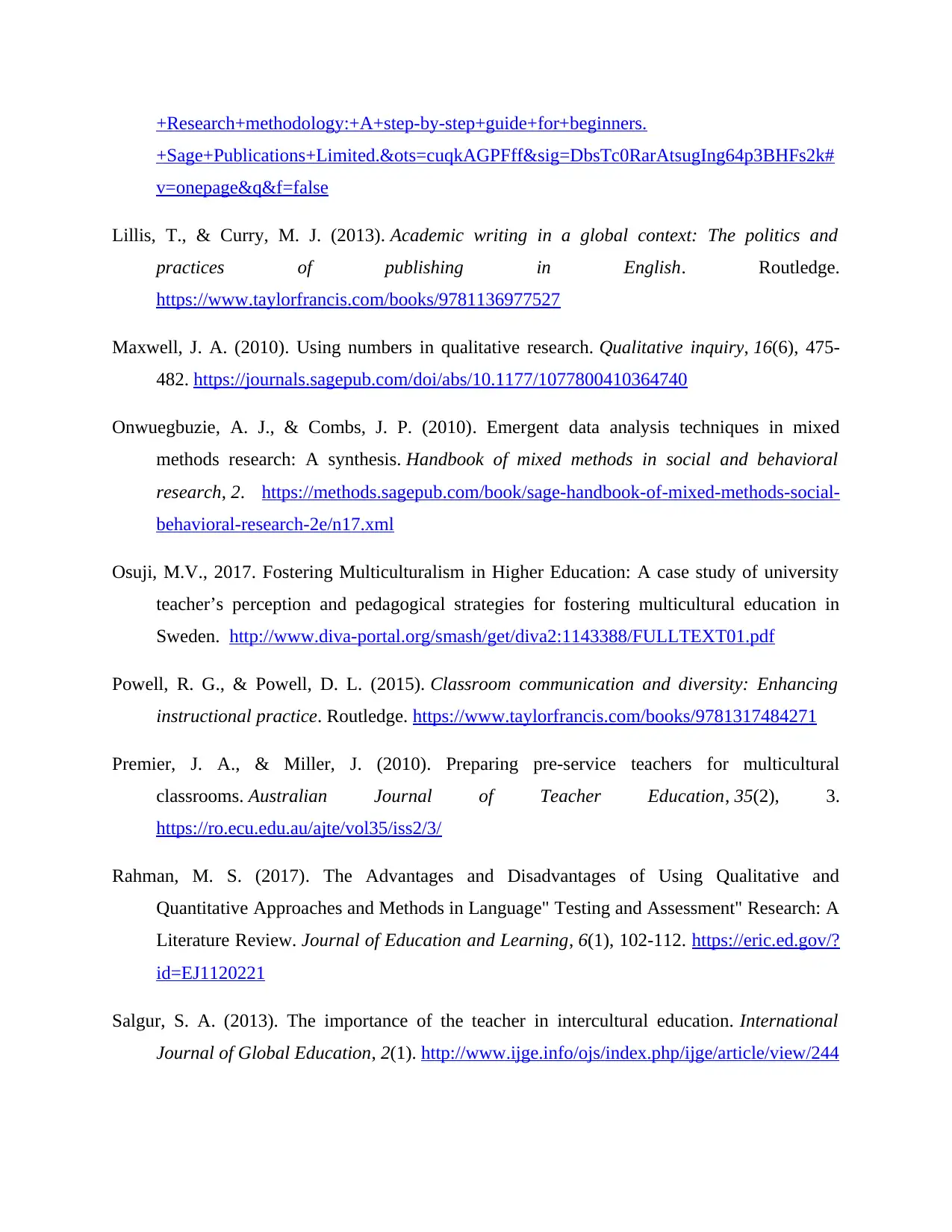
+Research+methodology:+A+step-by-step+guide+for+beginners.
+Sage+Publications+Limited.&ots=cuqkAGPFff&sig=DbsTc0RarAtsugIng64p3BHFs2k#
v=onepage&q&f=false
Lillis, T., & Curry, M. J. (2013). Academic writing in a global context: The politics and
practices of publishing in English. Routledge.
https://www.taylorfrancis.com/books/9781136977527
Maxwell, J. A. (2010). Using numbers in qualitative research. Qualitative inquiry, 16(6), 475-
482. https://journals.sagepub.com/doi/abs/10.1177/1077800410364740
Onwuegbuzie, A. J., & Combs, J. P. (2010). Emergent data analysis techniques in mixed
methods research: A synthesis. Handbook of mixed methods in social and behavioral
research, 2. https://methods.sagepub.com/book/sage-handbook-of-mixed-methods-social-
behavioral-research-2e/n17.xml
Osuji, M.V., 2017. Fostering Multiculturalism in Higher Education: A case study of university
teacher’s perception and pedagogical strategies for fostering multicultural education in
Sweden. http://www.diva-portal.org/smash/get/diva2:1143388/FULLTEXT01.pdf
Powell, R. G., & Powell, D. L. (2015). Classroom communication and diversity: Enhancing
instructional practice. Routledge. https://www.taylorfrancis.com/books/9781317484271
Premier, J. A., & Miller, J. (2010). Preparing pre-service teachers for multicultural
classrooms. Australian Journal of Teacher Education, 35(2), 3.
https://ro.ecu.edu.au/ajte/vol35/iss2/3/
Rahman, M. S. (2017). The Advantages and Disadvantages of Using Qualitative and
Quantitative Approaches and Methods in Language" Testing and Assessment" Research: A
Literature Review. Journal of Education and Learning, 6(1), 102-112. https://eric.ed.gov/?
id=EJ1120221
Salgur, S. A. (2013). The importance of the teacher in intercultural education. International
Journal of Global Education, 2(1). http://www.ijge.info/ojs/index.php/ijge/article/view/244
+Sage+Publications+Limited.&ots=cuqkAGPFff&sig=DbsTc0RarAtsugIng64p3BHFs2k#
v=onepage&q&f=false
Lillis, T., & Curry, M. J. (2013). Academic writing in a global context: The politics and
practices of publishing in English. Routledge.
https://www.taylorfrancis.com/books/9781136977527
Maxwell, J. A. (2010). Using numbers in qualitative research. Qualitative inquiry, 16(6), 475-
482. https://journals.sagepub.com/doi/abs/10.1177/1077800410364740
Onwuegbuzie, A. J., & Combs, J. P. (2010). Emergent data analysis techniques in mixed
methods research: A synthesis. Handbook of mixed methods in social and behavioral
research, 2. https://methods.sagepub.com/book/sage-handbook-of-mixed-methods-social-
behavioral-research-2e/n17.xml
Osuji, M.V., 2017. Fostering Multiculturalism in Higher Education: A case study of university
teacher’s perception and pedagogical strategies for fostering multicultural education in
Sweden. http://www.diva-portal.org/smash/get/diva2:1143388/FULLTEXT01.pdf
Powell, R. G., & Powell, D. L. (2015). Classroom communication and diversity: Enhancing
instructional practice. Routledge. https://www.taylorfrancis.com/books/9781317484271
Premier, J. A., & Miller, J. (2010). Preparing pre-service teachers for multicultural
classrooms. Australian Journal of Teacher Education, 35(2), 3.
https://ro.ecu.edu.au/ajte/vol35/iss2/3/
Rahman, M. S. (2017). The Advantages and Disadvantages of Using Qualitative and
Quantitative Approaches and Methods in Language" Testing and Assessment" Research: A
Literature Review. Journal of Education and Learning, 6(1), 102-112. https://eric.ed.gov/?
id=EJ1120221
Salgur, S. A. (2013). The importance of the teacher in intercultural education. International
Journal of Global Education, 2(1). http://www.ijge.info/ojs/index.php/ijge/article/view/244

Van Tartwijk, J., den Brok, P., Veldman, I., & Wubbels, T. (2009). Teachers’ practical
knowledge about classroom management in multicultural classrooms. Teaching and
teacher education, 25(3), 453-460.
https://www.sciencedirect.com/science/article/pii/S0742051X08001637
Yuen, C. Y. (2010). Dimensions of diversity: Challenges to secondary school teachers with
implications for intercultural teacher education. Teaching and Teacher Education, 26(3),
732-741. https://www.sciencedirect.com/science/article/pii/S0742051X09002078
knowledge about classroom management in multicultural classrooms. Teaching and
teacher education, 25(3), 453-460.
https://www.sciencedirect.com/science/article/pii/S0742051X08001637
Yuen, C. Y. (2010). Dimensions of diversity: Challenges to secondary school teachers with
implications for intercultural teacher education. Teaching and Teacher Education, 26(3),
732-741. https://www.sciencedirect.com/science/article/pii/S0742051X09002078
1 out of 18
Related Documents
Your All-in-One AI-Powered Toolkit for Academic Success.
+13062052269
info@desklib.com
Available 24*7 on WhatsApp / Email
![[object Object]](/_next/static/media/star-bottom.7253800d.svg)
Unlock your academic potential
© 2024 | Zucol Services PVT LTD | All rights reserved.





